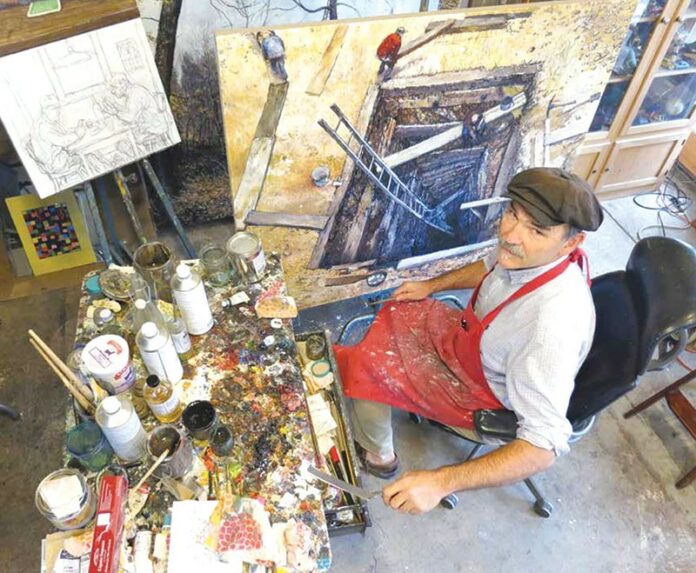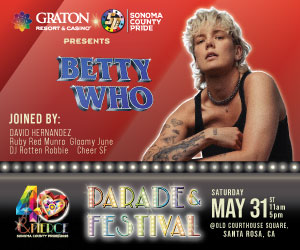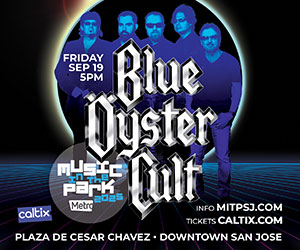Chester Arnold, perhaps the most impassioned and technically proficient California painter today, was born in Santa Monica and educated at the College of Marin and the Art Institute in San Francisco. For the past 25 years, he and his wife have lived in Sonoma.
On Arnold’s first visit to Sonoma, he and his wife bought cheese at Vella, a baguette at the Basque Bakery and then enjoyed a picnic on the grounds of General Vallejo’s old estate. They caught the Sonoma bug, bought a house and settled down. Then Arnold rolled up his sleeves and got to work. He hasn’t stopped.
His paintings are in the di Rosa Preserve, the Smithsonian American Art Museum, the Pasadena Museum of California Art and the San Jose Museum of Art. Yes, there are other great artists right here in our midst, including Bob Hudson, William Wiley and Bill Allan, but no one captures the contemporary Zeitgeist with more feeling than Arnold.
Over the past quarter of a century, he has painted pictures that some of his Sonoma neighbors find puzzling, if not down right irritating. If so, that’s probably Arnold’s intention—or at least part of it.
“I want to get under the viewer’s skin,” he says during an interview at the Sunflower Cafe, where he sips a cappuccino and sketches in one of the many notebooks that he quickly fills with ideas that pour out of his head all day long. With the publication of Evidence: Paintings by Chester Arnold 1989–2017, a new paperback book (Kelly’s Cove; $20) that offers 100 reproductions of his canvases, most of them in color, Arnold’s friends and neighbors have the opportunity to cast their critical eyes on a body of work that depicts a civilization going to wrack and ruin.
“People ask me why I paint dark subjects,” Arnold says. “It’s something I have thought about a lot. I’ll say this: my subjects come from a well of humanity that’s deep inside me. The painters I admire, like Honoré Daumier and Vincent van Gogh, created beauty from the dark side. . . . I feel like a street fighter.”
Indeed, Arnold is not an artist who wears gloves and a top hat, and he doesn’t think of himself as an aesthete.
Arnold’s most formative years were spent in Germany, near the peak of the Cold War, when his father worked as a spy for the United States. Not surprisingly, there’s something Germanic, and Northern European, too, about his temperament and his outlook on life. His ancestors came from Germany, Denmark and Holland. Moreover, from 1957, when he was five years old, to 1969, when he was 17, he soaked up a vast reservoir of almost all things German. Nearly everywhere Arnold looked he saw reminders of fascism and bombing by the Allies.
When he returned to the United States, he felt like an outsider, though he brought with him valuable Old World skills that have served him well in academia for nearly 50 years.
When he started out, Arnold’s art didn’t provide him with a living. For a time, he made money delivering the San Francisco Chronicle. When gallery owners such as Catharine Clark in San Francisco became fans of his work, he made money by selling paintings.
Now, at the Sunflower Cafe he shows me how he works. The first step is to take a notebook, turn it upside down and start from the back. Arnold is left-handed; working “backwards,” as he calls it, makes more sense than starting at the beginning of a notebook and going forward. Perhaps this way of sketching also explains his unconventional outlook on life and art.
“I start with a skeleton of an idea and then add color,” Arnold explains. “While I work with ideas and while I’m am stirred by politics, I also work intuitively. The topic chooses me. There’s a metaphor built into the best work I do, and a certain tension between the real and the abstract.”
Arnold opens Evidence and describes the stories he means to tell in his paintings, though most of them speak for themselves. He stops on pages 68 and 69, slightly more than halfway through the book, and looks at a work titled
A Natural History of Destruction that’s 18 inches high and 72 inches wide. “It’s a portrait of the city of Dresden after the Allies bombed it in 1945,” Arnold says. “But it could be most any city destroyed by war.”
On page 105, the painting titled Counterclockwise shows a group of men walking in a circle inside a brick structure without windows. “We’re all prisoners of our own ignorance,” Arnold says.
Now it’s nearly noon and he’s itching to get back to his notebook. Ideas have been calling him all morning. “The most exciting part of my life was when I first discovered the world of art,” Arnold says.
He’s still making discoveries and getting excited about creating art from darkness.
Jonah Raskin is the author of ‘Natives, Newcomers, Exiles, Fugitives: Northern California Writers and Their Work.’















